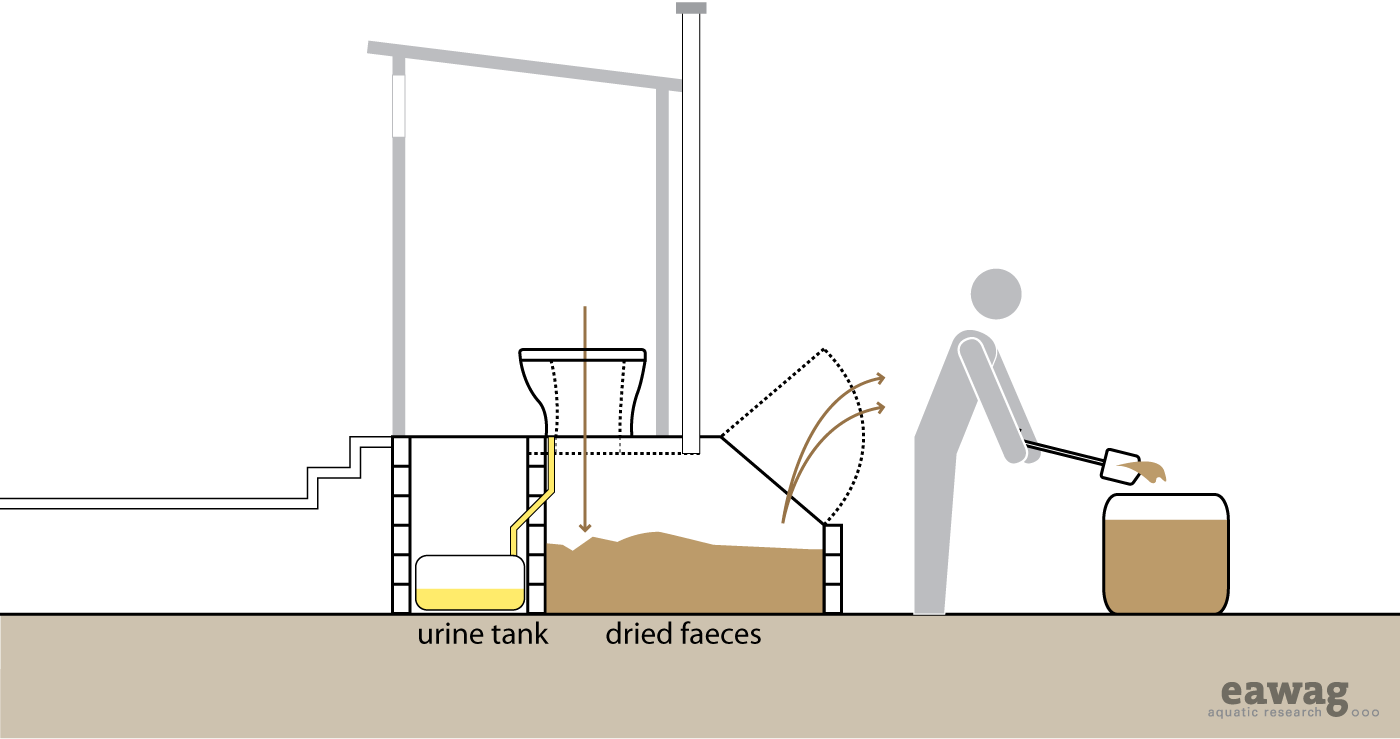Difference between revisions of "Application of Dehydrated Faeces"
(New page: <!-- table at top of page with logo, picture, Application level, Management level, and input-output tables --> {{santable| sys1=4| sys2=| sys3=| s...) |
|||
| Line 17: | Line 17: | ||
ManPublic=X| | ManPublic=X| | ||
Input1=Dried Faeces |Input2= |Input3= | Input4= |Input5=| | Input1=Dried Faeces |Input2= |Input3= | Input4= |Input5=| | ||
| − | Output1= |Output2= | Output3= | Output4= | Output5= | + | Output1=- |Output2= | Output3= | Output4= | Output5= |
}} | }} | ||
Revision as of 11:48, 4 March 2009
|

|
|
| |||||||||||||||||||||||||||||||
When faeces are stored in the absence of moisture (i.e. urine) they dehydrate into a crumbly, white-beige coarse, flaky material or powder. Dehydration means that the moisture naturally present in the faeces evaporates and/or is absorbed by the addition of a drying material (e.g. ash, sawdust, lime).
Dehydration is different from composting because the organic material present is not degraded or transformed; only the moisture is removed. After dehydration, faeces will reduce in volume by about 75%. The shells and carcasses of worms and insects that also dehydrate will remain in the dried faeces.
The degree of pathogen inactivation will depend on the temperature, the pH (e.g. lime raises the pH) and storage time. It is generally accepted that faeces should be stored between 12 to 18 months, although pathogens may still exist after this time.
When the faeces are completely dry they will emerge as a crumbly, powdery substance. The material is rich in carbon and nutrients, but may still contain pathogens or oocysts (spores which can survive extreme environmental conditions and re-animate under favourable conditions). The material can be mixed into soil, either for agriculture or at another site (depending on acceptance).
Faeces that are dried and stored between 2 and 20°C should be stored for between 1.5 to 2 years before they are used at the household or regional level. At higher temperatures (i.e. greater than 20°C) storage over one year is recommended to inactivate Ascaris eggs (a type of parasitic worm). A shorter storage time of six months is required if the faeces have a pH above 9 (i.e. lime will increase the pH of the faeces). The WHO has published guidelines and these should be consulted before using dried faeces.
| Advantages | Disadvantages/limitations |
|---|---|
| - Can improve the structure and water-holding capacity of soil. - Simple technique for all users. - Low cost. - Low risk of pathogen transmission. - May encourage income generation (tree planting. |
- Labour intensive. - Pathogens may exist in a dormant stage (oocysts) which may become infectious if moisture is added. - Does not replace fertilizer (N, P, K). |
Adequacy
Dried faeces are not as well treated or as useful as a soil amendment as composted faeces. However, they are useful at replenishing poor soils and for boosting the carbon and water-storing properties of a soil with low-risk of pathogen transmission.
Health Aspects/Acceptance
The handing and use of dried faeces may not be acceptable to some. However, because the dried faeces should be dry, crumbly, and odour free, the use of dried faeces may be more acceptable than that of manure or sludge. Dry faeces are a hostile environment for organisms and consequently, they do not survive (for long). If water or urine mixes with the drying faeces, odours and organisms may become problematic; wet faeces allow bacteria to survive and multiply. A warm, moist environment will permit anaerobic processes to generate offensive odours.
When removing the dehydrated faeces from the dehydration vaults, care must be taken to prevent the power from blowing and being inhaled.
Maintenance
Faeces should be kept as dry as possible. If by accident, water or urine enters mixes with the drying faeces, more ash, lime or dry soil can be added to help absorb the moisture. Prevention is the best way of keeping the faeces dry.
References
- Elizabeth Tilley et.al (2008). Compendium of Sanitation Systems and Technologies (low res version). Department of Water and Sanitation in Development Countries (Sandec) at the Swiss Federal Institute of Aquatic Science and Technology (Eawag). (Provides a full overview of sanitation systems.)
- Austin, A. and Duncker, L. (2002). Urine-diversion. Ecological Sanitation Systems in South Africa. CSIR, Pretoria.
- Schonning, C. and Stenstrom, TA. (2004). Guidelines for the Safe Use of Urine and Faeces in Ecological Sanitation Systems-Report 2004-1. EcosanRes, Stockholm Environment Institute, Stockholm, Sweden. Available: http://www.ecosanres.org
- WHO (2006). Guidelines for the safe use of wastewater, excreta and greywater – Volume 4: Excreta and greywater use in agriculture. WHO, Geneva. Available: http://www.who.int
- Winblad, U. and Simpson-Herbert, M. (eds.) (2004). Ecological Sanitation- revised and enlarged edition. Stockholm Environment Institute, Stockholm, Sweden. Available: http://www.ecosanres.org
